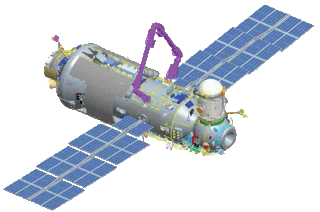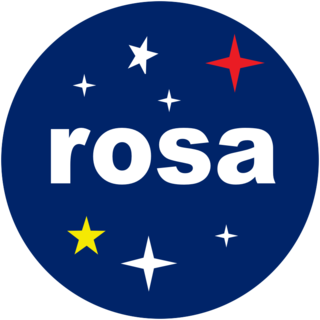Related Research Articles

Space weather is a branch of space physics and aeronomy, or heliophysics, concerned with the varying conditions within the Solar System and its heliosphere. This includes the effects of the solar wind, especially in the Earth's magnetosphere, ionosphere, thermosphere, and exosphere. Though physically distinct, space weather is analogous to the terrestrial weather of Earth's atmosphere. The term "space weather" was first used in the 1950s and popularized in the 1990s. Later, it prompted research into "space climate", the large-scale and long-term patterns of space weather.

Gaia is a space observatory of the European Space Agency (ESA), launched in 2013 and expected to operate until 2025. The spacecraft is designed for astrometry: measuring the positions, distances and motions of stars with unprecedented precision, and the positions of exoplanets by measuring attributes about the stars they orbit such as their apparent magnitude and color. The mission aims to construct by far the largest and most precise 3D space catalog ever made, totalling approximately 1 billion astronomical objects, mainly stars, but also planets, comets, asteroids and quasars, among others.

Venus Express (VEX) was the first Venus exploration mission of the European Space Agency (ESA). Launched in November 2005, it arrived at Venus in April 2006 and began continuously sending back science data from its polar orbit around Venus. Equipped with seven scientific instruments, the main objective of the mission was the long term observation of the Venusian atmosphere. The observation over such long periods of time had never been done in previous missions to Venus, and was key to a better understanding of the atmospheric dynamics. ESA concluded the mission in December 2014.

The European Robotic Arm (ERA) is a robotic arm that is attached to the Russian Orbital Segment (ROS) of the International Space Station. Launched to the ISS in July 2021; it is the first robotic arm that is able to work on the Russian Segment of the station. The arm supplements the two Russian Strela cargo cranes that were originally installed on the Pirs module, but were later moved to the docking compartment Poisk and Zarya module.

The Solar Orbiter (SolO) is a Sun-observing probe developed by the European Space Agency (ESA) with a National Aeronautics and Space Administration (NASA) contribution. Solar Orbiter, designed to obtain detailed measurements of the inner heliosphere and the nascent solar wind, will also perform close observations of the polar regions of the Sun which is difficult to do from Earth. These observations are important in investigating how the Sun creates and controls its heliosphere.

Aeolus, or, in full, Atmospheric Dynamics Mission-Aeolus (ADM-Aeolus), was an Earth observation satellite operated by the European Space Agency (ESA). It was built by Airbus Defence and Space, launched on 22 August 2018, and re-entered the atmosphere over Antarctica in a controlled manner and burned up on 28 July 2023. ADM-Aeolus was the first satellite with equipment capable of performing global wind-component-profile observation and provided much-needed information to improve weather forecasting. Aeolus was the first satellite capable of observing what the winds are doing on Earth, from the surface of the planet and into the stratosphere 30 km high.

Copernicus is the Earth observation component of the European Union Space Programme, managed by the European Commission and implemented in partnership with the EU Member States, the European Space Agency (ESA), the European Organisation for the Exploitation of Meteorological Satellites (EUMETSAT), the European Centre for Medium-Range Weather Forecasts (ECMWF), the Joint Research Centre (JRC), the European Environment Agency (EEA), the European Maritime Safety Agency (EMSA), Frontex, SatCen and Mercator Océan.

The Romanian Space Agency is a public institution with extra-budgetary funding that coordinates Romania's national space technology research programs and space research-related activities. ROSA was founded in 1991 and is subordinate to the Ministry of Education.

The European Cooperation for Space Standardization (ECSS) is a collaboration between the European Space Agency (ESA), the European space industry represented by Eurospace, and several space agencies, to develop and maintain a coherent, single set of user-friendly standards for use in all European space activities. Established in 1993 following a call by Eurospace to unify space products assurance standardization on a European level, it was officially adopted by the ESA on 23 June 1994 through the resolution ESA/C/CXIII/Res.1, to replace its own Procedures, Specifications and Standards (PSS) system. The ECSS currently has 139 active standards, forming the ECSS system. These standards cover management, engineering, product assurance, and space sustainability disciplines. The ECSS is managed by the ESA Requirement and Standard Division, based in the European Space Research and Technology Centre (ESTEC) in Noordwijk, the Netherlands. The ECSS maintains connections with multiple European and international standardization organizations, to contribute to standardization and to adopt relevant standards as part of the ECSS system.
Marco Polo was a proposed space mission concept studied between 2005 and 2015 that would return a sample of material to Earth from the surface of a Near Earth asteroid (NEA) for detailed study in laboratories. It was first proposed to the European Space Agency in collaboration with the Japan aerospace exploration agency JAXA. The concept was rejected four times between 2007 and 2015 for the Cosmic Vision programme "M" medium-class missions.
The European Data Relay System (EDRS) system is a European constellation of GEO satellites that relay information and data between satellites, spacecraft, UAVs, and ground stations. The first components were launched in 2016 and 2019.
The Exoplanet Characterisation Observatory (EChO) was a proposed space telescope as part of the Cosmic Vision roadmap of the European Space Agency, and competed with four other missions for the M3 slot in the programme. On 19 February 2014 the PLATO mission was selected in place of the other candidates in the programme, including EChO.
The Consultative Committee for Space Data Systems (CCSDS) was founded in 1982 for governmental and quasi-governmental space agencies to discuss and develop standards for space data and information systems. Currently composed of "eleven member agencies, twenty-eight observer agencies, and over 140 industrial associates," the CCSDS works to support collaboration and interoperability between member agencies through the establishment of data and system standards. According to the organisation's website, more than 1000 space missions have utilized data and systems standards created by CCSDS. The activities of the CCSDS are organized around six topic areas and composed of many working groups within the overall Collaborative Working Group Environment (CWE).

LISA Pathfinder, formerly Small Missions for Advanced Research in Technology-2 (SMART-2), was an ESA spacecraft that was launched on 3 December 2015 on board Vega flight VV06. The mission tested technologies needed for the Laser Interferometer Space Antenna (LISA), an ESA gravitational wave observatory planned to be launched in 2037. The scientific phase started on 8 March 2016 and lasted almost sixteen months. In April 2016 ESA announced that LISA Pathfinder demonstrated that the LISA mission is feasible.
The Space Safety Programme, formerly the Space Situational Awareness (SSA) programme, is the European Space Agency's (ESA) initiative to monitor hazards from space, determine their risk, make this data available to the appropriate authorities and where possible, mitigate the threat.

Solar wind Magnetosphere Ionosphere Link Explorer (SMILE) is a planned joint venture mission between the European Space Agency and the Chinese Academy of Sciences. SMILE will image for the first time the magnetosphere of the Sun in soft X-rays and UV during up to 40 hours per orbit, improving our understanding of the dynamic interaction between the solar wind and Earth's magnetosphere. The prime science questions of the SMILE mission are

Sentinel-4 is a European Earth observation mission developed to support the European Union Copernicus Programme for monitoring the Earth. It focuses on monitoring of trace gas concentrations and aerosols in the atmosphere to support operational services covering air-quality near-real time applications, air-quality protocol monitoring and climate protocol monitoring. The specific objective of Sentinel-4 is to support this with a high revisit time over Europe.

The Vegetable Production System (Veggie) is a plant growth system developed and used by NASA in outer space environments. The purpose of Veggie is to provide a self-sufficient and sustainable food source for astronauts as well as a means of recreation and relaxation through therapeutic gardening. Veggie was designed in conjunction with ORBITEC and is currently being used aboard the International Space Station, with another Veggie module planned to be delivered to the ISS in 2017.

The Space Rider is a planned uncrewed orbital lifting body spaceplane aiming to provide the European Space Agency (ESA) with affordable and routine access to space. Contracts for construction of the vehicle and ground infrastructure were signed in December 2020. Its maiden flight is currently scheduled for the third quarter of 2025.
Biomass is an Earth observing satellite planned for launch by the European Space Agency (ESA) in 2024 on a Vega launch vehicle.
References
- ↑ esa. "ESA". European Space Agency. Retrieved 2019-03-20.
- ↑ "Query Results". adsabs.harvard.edu. Retrieved 2019-03-20.
- ↑ "Help: Table of contents". www.spenvis.oma.be. Retrieved 2019-03-20.